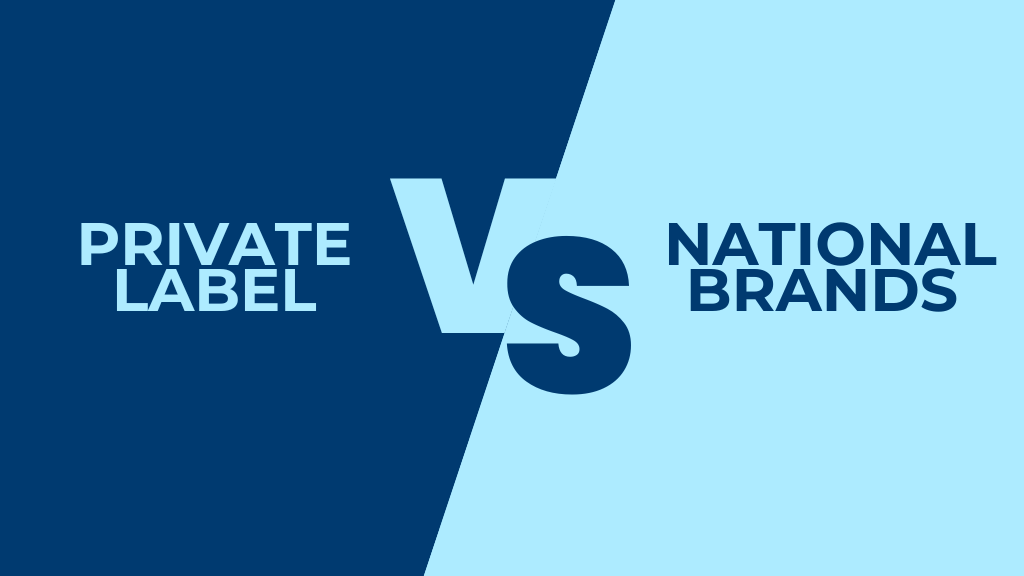

There are more and more private label products on the market. In 2023, they represented 35% of all Fast Moving Consumer Goods (FMCG) in Europe, while in the United States, they accounted for 21%, an increase of over 8%. This type of product is manufactured by a third party but labelled and sold by a specific retailer. Examples include Costco’s Kirkland, Aldi’s Milsani brand, and Leroy Merlin’s Luxens.
Private label goods, also known as white label or store brand, are widespread among fast-moving consumer goods, consumer packaged goods, and consumer goods. In addition to the food sector, they are also gaining ground in the beauty, sport, DIY, fashion, electronics, and household appliance categories.
As they are cost-effective, private label products are increasingly popular during economic crises and when there is financial uncertainty, winning market share over traditional brands.
It is crucial to monitor prices, ratings, and reviews of private-label products to avoid losing a percentage of sales. Our Competitive Environment tool allows you to monitor private label product prices and compare them with your products.
Why consumers buy white label products
White label products or distributor brands significantly impact consumers’ behaviour for various reasons:
- Price sensitivity: 63% of consumers choose private label products1 because they are cheaper. As inflation increases, price sensitivity increases and consumers want to spend less on their shopping. They swap traditional brands for more cost-effective alternatives or substitute products.
- Perception of quality: Although white-label goods used to be seen as inferior quality, now consumers say that the quality of these products has significantly improved. That’s why 96% of consumers buy private label products 1.
- Wider variety of white label products: The range of store brands products increases as consumers look for cheaper alternatives. 82% of consumers already choose white label fashion, and 69% choose white label electronics products.
- The store’s brand value: High-quality retailer products have become an important driver in increasing customers’ loyalty. Retailers that develop their own brands can convert customers looking for a cheaper alternative in the short term into loyal customers in the long term.
Competition between brands: White label products make sense because national or manufacturer brands exist. They offer a more cost-effective alternative to more well-known products. White label products need manufacturer brands to survive so that the consumer can compare them and choose the best option at any given moment. The most effective strategy for any retailer is to offer a mix of brands.
1: Salsify - 2023 Shopper Research
If you manufacture a brand and need to know your market positioning and competitiveness, you can do so by comparing your brand’s prices, characteristics, and ratings against white label products. Minderest’s Competitive Environment tool can help you compare product by product.

Pricing of private label vs national brands
White label products are emerging as a cheaper alternative to more well-known brands. Apart from the RRP, customer perception is the most significant determining factor when choosing between a national brand and a private-label product.
- If there is a significant difference between the price of a product and its alternative, consumers tend to choose the cheaper product, particularly if they think that both products are very similar. This happens due to the price anchoring bias.
- On the other hand, if the price difference is negligible, the consumer will likely choose the manufacturer’s brand product because they think it has better characteristics or guarantees.
Most of the time, the manufacturer has no say in the final price of a product, although they can use various strategies to improve consumers’ value perception, for example:
- Higher volume, lower price: For example, as with drinks, offering a lower price per litre the greater the quantity of the product, or buying a non-separable pack.
- Free gifts with every purchase: Include merchandising as a free gift or to add value to the product.
- Special after-sales promotions: For example, including codes in packaging so that consumers can collect points which can be exchanged for exclusive gifts.
- RRP on the label: This practice tends to stop the distributor from changing the price of a product.
Any strategy that increases the end consumer’s perceived value of a product needs in-depth analysis beforehand. This analysis provides the key to identifying your competitive positioning for these private label products with different retailers. You can analyze the current price, average price, and how it changes over time, as well as the ratings and customer reviews for alternative products.
Our Competitive Environment tool can carry out this analysis by monitoring the prices of white label products as it has:
- The most advanced matching algorithm on the market, with artificial intelligence, and the ability to match identical, similar, or white label products.
- High-quality data: Accurate, comprehensive, consistent, reliable and up-to-date.
- A fully customizable dashboard for constant analysis.
Fill out the form below to see our tool in action.
Find out how Minderest can take your business to the next level.
Contact our pricing experts to see the platform in action.
Related Articles

How to select the best pricing tool for the retail sector
In the competitive retail sector, price intelligence has become critical to success. Knowing your competitors’ prices, market fluctuations, and consumer trends allows you to make strategic...
How to price private label or white label brands?
Private Label Brands, also known as White Label, continue to win market share. According to data from the Private Label Manufacturers Association, in the first half of 2024 they reached a 38.6%...